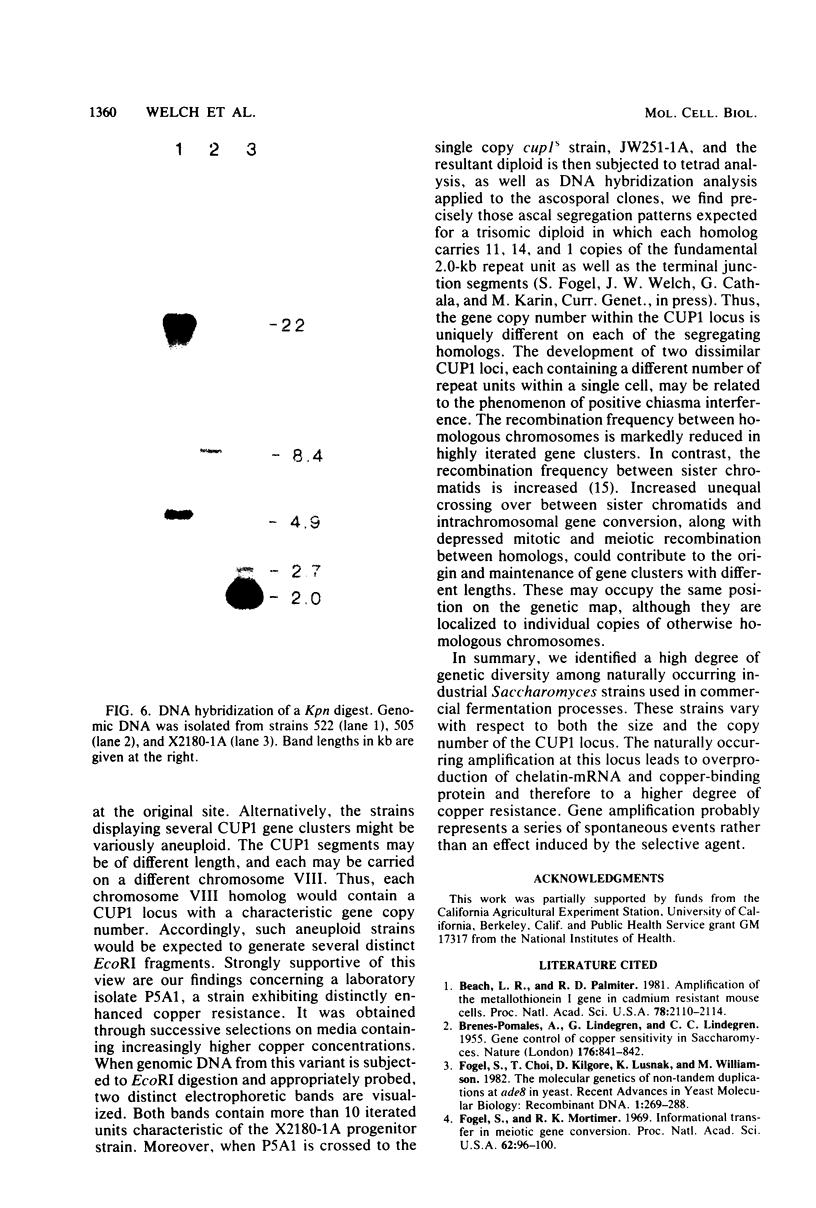Abstract
The gene copy number at the CUP1 locus and the resistance level to external copper was directly correlated in five wild-type commercial Saccharomyces strains. An increased copy number of the CUP1 gene leads to increased accumulation of chelatin mRNA, which codes for a low-molecular-weight, copper-binding protein. The enhanced production of this rapidly inducible protein mediates resistance of the cell to copper. Industrial yeasts exhibit homologies to the amplified copper resistance repeat unit found in laboratory strains. However, the extent of tandem iteration is strain dependent, and the repetitious unit is either 1.7 or 1.5 kilobases in length compared with the 2.0-kilobase unit in laboratory strains. Strain 522 (Montrachet) contains two chromosome VIII segments distinguishable by their numbers of repeat units (2 and 11) and the size of the units (1.5 and 1.7 kilobases). Distillers yeast 513 carries a 1.5-kilobase repeat unit on each homologous chromosome, although they contain nine and five iterations, respectively.
Full text
PDF








Images in this article
Selected References
These references are in PubMed. This may not be the complete list of references from this article.
- BRENES-POMALES A., LINDEGREN G., LINDEGREN C. C. Gene control of coppersensitivity in Saccharomyces. Nature. 1955 Oct 29;176(4487):841–842. doi: 10.1038/176841a0. [DOI] [PubMed] [Google Scholar]
- Beach L. R., Palmiter R. D. Amplification of the metallothionein-I gene in cadmium-resistant mouse cells. Proc Natl Acad Sci U S A. 1981 Apr;78(4):2110–2114. doi: 10.1073/pnas.78.4.2110. [DOI] [PMC free article] [PubMed] [Google Scholar]
- Fogel S., Mortimer R. K. Informational transfer in meiotic gene conversion. Proc Natl Acad Sci U S A. 1969 Jan;62(1):96–103. doi: 10.1073/pnas.62.1.96. [DOI] [PMC free article] [PubMed] [Google Scholar]
- Fogel S., Welch J. W. Tandem gene amplification mediates copper resistance in yeast. Proc Natl Acad Sci U S A. 1982 Sep;79(17):5342–5346. doi: 10.1073/pnas.79.17.5342. [DOI] [PMC free article] [PubMed] [Google Scholar]
- Petes T. D., Botstein D. Simple Mendelian inheritance of the reiterated ribosomal DNA of yeast. Proc Natl Acad Sci U S A. 1977 Nov;74(11):5091–5095. doi: 10.1073/pnas.74.11.5091. [DOI] [PMC free article] [PubMed] [Google Scholar]
- Premakumar R., Winge D. R., Wiley R. D., Rajagopalan K. V. Copper-chelatin: isolation from various eucaryotic sources. Arch Biochem Biophys. 1975 Sep;170(1):278–288. doi: 10.1016/0003-9861(75)90118-6. [DOI] [PubMed] [Google Scholar]
- Rigby P. W., Dieckmann M., Rhodes C., Berg P. Labeling deoxyribonucleic acid to high specific activity in vitro by nick translation with DNA polymerase I. J Mol Biol. 1977 Jun 15;113(1):237–251. doi: 10.1016/0022-2836(77)90052-3. [DOI] [PubMed] [Google Scholar]
- Southern E. M. Detection of specific sequences among DNA fragments separated by gel electrophoresis. J Mol Biol. 1975 Nov 5;98(3):503–517. doi: 10.1016/s0022-2836(75)80083-0. [DOI] [PubMed] [Google Scholar]
- St John T. P., Davis R. W. The organization and transcription of the galactose gene cluster of Saccharomyces. J Mol Biol. 1981 Oct 25;152(2):285–315. doi: 10.1016/0022-2836(81)90244-8. [DOI] [PubMed] [Google Scholar]
- Struhl K., Stinchcomb D. T., Scherer S., Davis R. W. High-frequency transformation of yeast: autonomous replication of hybrid DNA molecules. Proc Natl Acad Sci U S A. 1979 Mar;76(3):1035–1039. doi: 10.1073/pnas.76.3.1035. [DOI] [PMC free article] [PubMed] [Google Scholar]
- Szostak J. W., Wu R. Unequal crossing over in the ribosomal DNA of Saccharomyces cerevisiae. Nature. 1980 Apr 3;284(5755):426–430. doi: 10.1038/284426a0. [DOI] [PubMed] [Google Scholar]
- Thomas P. S. Hybridization of denatured RNA and small DNA fragments transferred to nitrocellulose. Proc Natl Acad Sci U S A. 1980 Sep;77(9):5201–5205. doi: 10.1073/pnas.77.9.5201. [DOI] [PMC free article] [PubMed] [Google Scholar]
- Wahl G. M., Padgett R. A., Stark G. R. Gene amplification causes overproduction of the first three enzymes of UMP synthesis in N-(phosphonacetyl)-L-aspartate-resistant hamster cells. J Biol Chem. 1979 Sep 10;254(17):8679–8689. [PubMed] [Google Scholar]






